Four years ago, chemists developed a Lego-like methodology to prepare giant molecular aromatics. Now, the same team has broken all the records by crafting a huge twisted nanoribbon almost 13nm long, featuring 53 linearly fused rings and over 320 conjugated atoms. The molecule also exhibits exciting optoelectronic properties.1
‘Making giant aromatics is a very difficult task,’ explains Aurelio Mateo-Alonso of Polymat in Spain, who led the study. ‘Large aromatic structures pile-up into stacks, which renders them insoluble and nearly intractable materials that cannot be purified and characterised with traditional techniques,’ he adds. Twisted aromatics include sterically crowded moieties that force them into curled arrangements, making them less prone to form stacks and generally more soluble than their planar counterparts.
The team already held the record for longest molecular nanoribbon, with a design from 2018 that featured 30 linearly fused rings.2 Back then, this doubled the previous record – a 16-ring nanoribbon that was practically insoluble and hard to characterise. ‘Then, we used an iterative synthetic approach, combining pyrene and nitrogen-doped anthracene building blocks,’ explains Mateo-Alonso. However, they had to completely redesign the process to achieve longer systems. ‘Instead of progressively adding small pieces, we decided to prepare bigger units and combine them later,’ he adds. To enhance solubility, they added alkyl-silyl side groups and introduced coronene junctions – which enable the twist. ‘Combined [with] side-groups and multiple twists along the nanoribbon backbone, we increased the solubility to levels that we could not imagine,’ says Mateo-Alonso.
The team also carried out computational studies to better understand the properties of twisted nanoribbons. ‘Calculating their electronic properties was not very straightforward given their large dimensions,’ explains Manuel Melle-Franco from Ciceco, Portugal, who carried out the computational work.’ To our delight the theoretical properties correlate very well with the experimental ones.’
Chunyan Chi, an expert in π-conjugated systems at the National University of Singapore, says that ‘the breakthrough is the synthesis of a new family of molecular nanoribbons that exceed both the largest lengths and [number of] aromatic cores [previously] reported’. She also values the synthetic strategy, and remarks how ‘the twisted aromatic framework, together with the presence of carefully selected solubilising groups, resulted in an excellent solubility in common organic solvents at room temperature’. Among other things, this enabled a straightforward purification by column chromatography and broad characterisation of the new nanoribbons, using common techniques such as NMR, UV-vis and fluorescence spectroscopies.
Max von Delius, an expert in supramolecular organic systems at Ulm University, Germany, comments that preparing these compounds is interesting ‘from a fundamental perspective’. Contrary to graphene, nanoribbons have a tuneable bandgap, which is very attractive for applications in optoelectronics, photonics and photovoltaics. ‘It’s very rare that we observe grey-coloured solutions [with] intense absorption of visible light over a broad spectral range,’ says von Delius. ‘[These molecules] may very well find applications in photodetectors,’ he adds.
Von Delius also highlighted the value of the Lego-like modular synthesis. The side chains could be tailored, further enhancing the processability of the molecules in solution. Moreover, he believes introducing moieties like sulfur atoms could bind the nanoribbons to noble metal electrodes, enabling the fabrication of single molecule transistors. ‘The strategic use of nitrogen atoms … to guarantee bench stability of the products is also impressive,’ he adds.
Mateo-Alonso explains that, beyond light absorption, their twisted nanoribbons also exhibit red fluorescence. ‘This was really surprising, light emission is an unusual effect in giant aromatics,’ he says. ‘These results hint at potential applications in light-emitting diodes and lasers.’ The group is already exploring new record-breaking molecules and further applications for their giant aromatics.
References
1 RK Dubey, M Melle-Franco and A Mateo-Alonso, J. Am. Chem. Soc., 2021, 147, 6593 (DOI: 10.1021/jacs.1c01849)
2 D Cortizo-Lacalle, et al, Angew. Chem., Int. Ed., 2018, 57, 703 (DOI: 10.1002/anie.201710467)










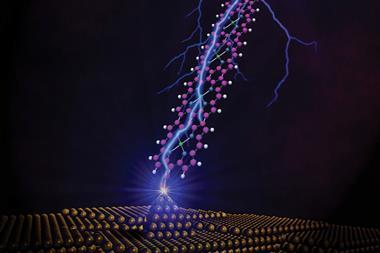
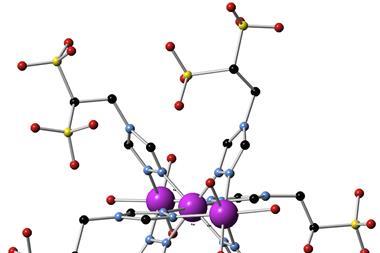

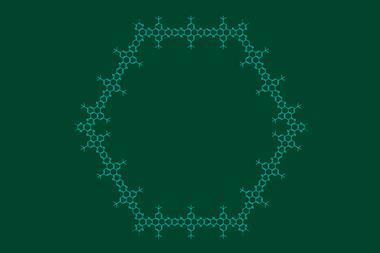
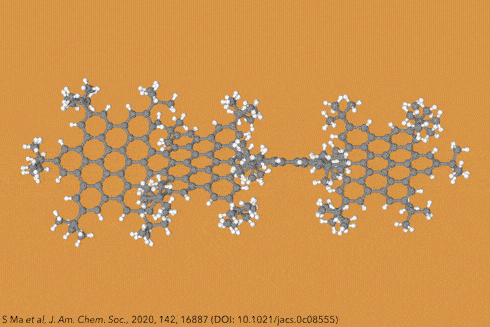
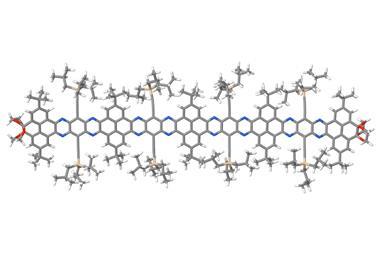











No comments yet